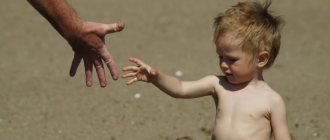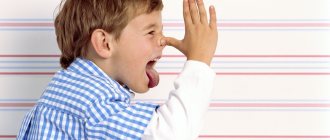School maladjustment - what is it, concept
With the beginning of educational activities, big changes appear in the child’s life. At this stage, his psyche may experience stress due to changes in lifestyle, new demands from parents and teachers.
Therefore, it is extremely important to monitor the general condition of the student and help him avoid difficulties in the process of adaptation to the school environment.
This article will discuss the concept of school maladaptation, its main causes, types of manifestation, and also provide recommendations for correction and prevention developed by psychologists and teachers.
School maladjustment does not have an unambiguous definition in science, because in every science, be it pedagogy, psychology and social pedagogy, this process is studied from a certain professional angle.
School maladjustment is a violation of the child’s adequate mechanisms of adaptation to the school environment, affecting his educational productivity and relationships with the outside world. If we bypass scientific terminology, then in other words, school maladjustment is nothing more than a psychosomatic deviation that prevents a child from adapting to the school environment.
According to psychologists, schoolchildren who experience difficulties in adaptation may have problems mastering school material, resulting in low academic performance, as well as difficulties in forming social contacts both with peers and with adults.
The personal development of such children, as a rule, is delayed; they are infantile, deceitful, subject to the influence of others, and do not hear their “I”. Most often, younger schoolchildren face maladaptation, but in some cases, high school students as well.
As a rule, children with this kind of problems in primary school stand out from the entire team:
- emotional instability;
- frequent absence from school;
- sudden transitions from passivity to activity;
- frequent complaints of feeling unwell;
- lagging behind the curriculum.
High school children who have difficulty adapting are more likely to:
- - increased sensitivity, sudden outbursts of emotions;
- - the emergence of aggressiveness, conflicts with others;
- - negativism and protest;
- - manifestation of character through appearance;
- - can keep up with the curriculum.
What is child adaptation?
Adaptation is the ability to adapt to circumstances, new conditions of life and activity, behavioral contacts of social roles of the environment. For a 6-7 year old child - adaptation to a new rhythm of physiological and socio-psychological stress, changes in the behavioral algorithm of the cognitive sphere, development of perception, memory, and thinking. In the preschool period, the foundations for the behavioral reactions of the future schoolchild are laid.
Causes of school maladjustment
Psychologists studying the phenomenon of maladjustment identify the following among the main reasons:
- strong suppression by parents and teachers - overprotection (fear of failure, shame, fear of making mistakes);
- disorders of a somatic nature (weak immunity, diseases of internal organs, physical fatigue);
- poor preparation for school (lack of certain knowledge and skills, poor motor skills);
- poorly formed foundation of some mental functions, as well as cognitive processes (inadequately high or low self-esteem, inattention, poor memory);
- specifically organized educational process (complex program, special bias, fast pace).
Social maladjustment of adolescents
The process of socialization is the introduction of a child into society. This process is characterized by complexity, multifactoriality, multidirectionality and poor forecasting in the end. The socialization process can last a lifetime. One should not deny the impact of the innate qualities of the body on personal properties. After all, the formation of personality occurs only as a person is included in the surrounding society.
One of the prerequisites for the formation of personality is interaction with other subjects who transfer accumulated knowledge and life experience. This is accomplished not through simple mastery of social relations, but as a result of the complex interaction of social (external) and psychophysical (internal) developmental inclinations. And it represents the cohesion of socially typical traits and individually significant qualities. It follows from this that personality is socially conditioned and develops only in the process of life, in a change in the child’s attitude to the surrounding reality. From this we can conclude that the degree of socialization of an individual is determined by many components, which, when combined, form the overall structure of the influence of society on an individual. And the presence of certain defects in each of these components leads to the formation in the individual of social and psychological qualities that can lead the individual in specific circumstances to conflict situations with society.
Under the influence of socio-psychological conditions of the external environment and in the presence of internal factors, the child develops maladjustment, manifested in the form of abnormal - deviant behavior. Social maladaptation of adolescents arises from violations of normal socialization and is characterized by deformation of the referent and value orientations of adolescents, a decrease in the significance of the referent character and alienation, first of all, from the influence of teachers at school.
Depending on the degree of alienation and the depth of the resulting deformations of value and reference orientations, two phases of social maladjustment are distinguished. The first phase consists of pedagogical neglect and is characterized by alienation from school and loss of referent significance at school while maintaining a fairly high reference significance in the family. The second phase is more dangerous and is characterized by alienation from both school and family. The connection with the main institutions of socialization is lost. The assimilation of distorted value-normative ideas occurs and the first criminal experience appears in youth groups. The result of this will be not only a lag in learning, poor performance, but also increasing psychological discomfort that adolescents experience at school. This pushes adolescents to search for a new, non-school communication environment, another reference group of peers, which subsequently begins to play a leading role in the process of socialization of adolescents.
Factors of social maladaptation of adolescents: exclusion from the situation of personal growth and development, neglect of the personal desire for self-realization, self-affirmation in a socially acceptable way. The consequence of maladaptation will be psychological isolation in the communicative sphere with a loss of the sense of belonging to its inherent culture, a transition to attitudes and values that dominate the microenvironment.
Unmet needs can lead to increased social activity. And it, in turn, can result in social creativity and this will be a positive deviation, or it will manifest itself in antisocial activity. If she does not find a way out, she may seek a way out by becoming addicted to alcohol or drugs. The most unfavorable development is a suicide attempt.
The current social and economic instability, the critical state of the health care and education systems not only does not contribute to the comfortable socialization of the individual, but also aggravates the processes of maladaptation of adolescents associated with problems in family upbringing, which lead to even greater anomalies in the behavioral reactions of adolescents. Therefore, the process of socialization of adolescents is increasingly becoming negative. The situation is aggravated by the spiritual pressure of the criminal world and their values, rather than civil institutions. The destruction of the main institutions of socialization leads to an increase in crime among minors.
Also, the sharp increase in the number of maladjusted adolescents is influenced by the following social contradictions: indifference to smoking in secondary schools, the lack of an effective method of combating truancy, which today has practically become the norm of school behavior, along with the ongoing reduction in educational and preventive work in government organizations and institutions that deal with leisure and raising children; replenishment of juvenile gangs of criminals due to teenagers who have dropped out of school and are lagging behind in their studies, along with a decrease in social relationships between families and teachers. This makes it easier for teenagers to establish contacts with juvenile criminal groups, where illegal and deviant behavior develops freely and is welcomed; crisis phenomena in society that contribute to the growth of anomalies in the socialization of adolescents, along with a weakening of the educational influence on adolescents of public groups that should exercise education and public control over the actions of minors.
Consequently, the increase in maladjustment, deviant behavior, and teenage crime is the result of the global social alienation of children and youth from society. And this is a consequence of a violation of the immediate processes of socialization, which have become uncontrollable and spontaneous in nature.
Signs of social maladaptation of adolescents associated with such an institution of socialization as school:
The first sign is poor academic performance in the school curriculum, which includes: chronic underachievement, repeating a year, insufficient and fragmentary acquired general educational information, i.e. lack of a system of knowledge and skills in studies.
The next sign is systematic violations of an emotionally charged personal attitude towards learning in general and some subjects in particular, towards teachers, and life prospects related to learning. Behavior can be indifferent-indifferent, passive-negative, demonstrative-dismissive, etc.
The third sign is regularly recurring anomalies of behavior during school learning and in the school environment. For example, passive-refusal behavior, lack of contact, complete refusal of school, persistent behavior with violation of discipline, characterized by oppositional defiant actions and including active and demonstrative opposition of one’s personality to other students and teachers, disregard for the rules adopted at school, vandalism at school .
Types of manifestation of school maladjustment
1. Cognitive – manifests itself as the student’s general poor performance. There may be chronic underachievement, lack of skills, fragmentary acquisition of knowledge. Lack of adaptation to the collective pace - being late for lessons, taking a long time to complete a task, getting tired easily.
2. Emotionally - evaluative - there are violations of the emotional attitude towards individual lessons, teachers, and possibly to learning in general. “Fear of school” is a child’s reluctance to go to class, anxiety, tension. Uncontrolled manifestation of violent emotions.
3. Behavioral – weak self-regulation, inability to control one’s own behavior, aggression and conflict appear. Lack of learning motivation manifests itself in a reluctance to do homework and a desire to engage in other activities.
The child's daily routine during the adaptation period
The daily routine is built taking into account the age and individual characteristics of the central nervous system (CNS). A properly organized schoolchild’s daily routine is based on a certain rhythm, a strict alternation of individual elements of the regimen. When individual elements of the daily routine are performed in a certain sequence, at the same time, complex connections are created in the central nervous system, facilitating the transition from one type of activity to another and their implementation with the least amount of energy. Therefore, it is necessary to strictly adhere to a certain time of getting up and going to bed, preparing homework, eating, i.e. follow a certain, established daily routine.
Walks
Staying outdoors is the most effective type of recreation, which is due to increased blood oxygenation and replenishment of ultraviolet deficiency. Walking will strengthen the body and increase physical activity. The best option is to stay outdoors in a park, outside the city, excluding polluted city streets. The total duration of active outdoor recreation depends on the age group: at primary school age - 3.5 hours, on average - 2.5-3 hours, at senior school age - 2-2.5 hours. As the child grows and develops, endurance to the load increases, the body gets used to doing a lot of work without fatigue. Organization of the regime and its optimal compliance by children contributes to maintaining or improving health, increasing the efficiency of study and internal self-organization.
Child nutrition
For a growing organism, the supply of complete macro- and micronutrients is of great importance: protein, lipids, carbohydrates, vitamins and microelements:
- Animal proteins must make up at least 50% of the total protein. In the first half of the day, schoolchildren are given foods richer in protein, and for dinner - dairy-vegetable dishes. Milk remains an important product, but its amount is gradually reduced, taking into account the decrease in lactase activity in the intestines, recommending fermented milk products (biokefir, cottage cheese, etc.) enriched with probiotics.
- Vegetable fats make up up to 20% of the total fat in the diet; omega-3 polyunsaturated fatty acids found in fish and nuts are recommended.
- The need for carbohydrates depends on age, the state of metabolic processes, mental and physical activity (the consumption of refined simple carbohydrates should be limited).
- The ratio of proteins, fats and carbohydrates is 1:1:4.
Nutrition plays an exceptional role in the lives of children and is an important component of maintaining and strengthening the health of children at any age.
Correction of maladjustment in school-age children
Currently, there is no unified method for solving problems with the adaptation of a schoolchild, since this problem includes several aspects of a child’s life. Here you need to take into account the medical, pedagogical, psychological and social aspects.
It is for this reason that it is necessary to understand the seriousness of this problem and solve it through qualified specialists.
Since psychological assistance in resolving this issue is the main one, either a school psychologist or a private psychologist, or in some cases a psychotherapist, can work with a child experiencing difficulties.
Specialists, in turn, to determine methods for correcting school maladaptation, conduct a detailed study of the student’s life and identify the main points:
- learn in detail about the child’s social environment, the conditions of his development, collecting a detailed anamnesis;
- assess the level of psychophysical development of the child, taking into account his individual characteristics, conduct special tests appropriate to the child’s age;
- determine the nature of the student’s internal conflict leading to crisis situations;
- identify factors that provoke manifestations of signs of maladjustment;
- draw up a program of psychological and pedagogical correction, focusing specifically on the individual characteristics of a given child.
Teachers are also inextricably linked with the process of creating positive conditions for student adaptation. It is necessary to focus on creating comfort in the lesson, a favorable emotional climate in the class, and to be more restrained.
But it is important to understand that without family support , the chances of developing positive dynamics are quite limited. That is why parents need to build friendly relationships with their children, encourage them more often, try to help and, of course, praise them. It is necessary to spend time together, play, come up with joint activities, and help develop the necessary skills.
If a child does not have a good relationship with a teacher at school or with peers (outcast option), parents are advised to consider options for transferring to another school. There is a possibility that in another school the child will become interested in educational activities and will also be able to establish contacts with others.
The role of parents in children's adaptation
How parents can help their child adapt to school:
- during the child’s adaptation, it is necessary to maintain constant communication with teachers, to participate in the correction of the existing syndrome, based on constant information about what the child has achieved at school, his successes and shortcomings;
- if something cannot be corrected when interacting with the teacher, you need to contact a psychologist;
- homework must be completed together with the child, explain the course of action to him, praise him and provide assistance in the issue that arises;
- Do not tire your child by repeatedly rewriting the exercise;
- the main task of parents, in connection with the decrease in physical activity of children during school, is to monitor and ensure an increase in physical exercises;
- try to do morning exercises with your child and an evening walk before bed;
- increase walking time;
- strict adherence to the daily routine;
- increasing sleep and rest time to fully restore physical and mental ability;
- provide rational nutrition;
- to overcome negative psychological symptoms, use family therapy methods (joint walks and friendly conversations, family reading books to the child, identifying and developing the child’s interests, etc.)
Prevention of school maladjustment
In solving this problem, both correction methods and prevention methods should be comprehensive. Today, various measures are provided to help a child with maladjustment.
These are compensatory classes, social trainings, qualified consultations for parents, special correctional teaching methods that are taught to school teachers.
Adaptation to the school environment is a stressful process not only for the child, but also for parents and teachers. That is why the task of adults at this stage of a child’s life is to try to help him together.
Here all efforts are devoted to only one important result - to restore the child’s positive attitude towards life, teachers and the educational activity itself.
With the advent of positive thinking, the student will become interested in lessons, perhaps in creativity and in others. When it is clear that the child has begun to experience joy in the school environment and the learning process, then school will cease to be a problem.
Stages of child adaptation
Main stages of physiological adaptation:
The first stage of a child’s adaptation to school
Indicative - in response to the whole complex of new influences associated with the beginning of systematic training, almost all systems of the body respond with a violent reaction and significant tension (two to three weeks);
The second stage of a child’s adaptation to school
Unstable adaptation - the body searches and finds optimal (or close to optimal) variants of reactions to these influences (one to two weeks);
The third stage of a child’s adaptation to school
Relatively stable device - suitable options for responding to load, requiring less stress on all systems.
Prolonged stress and associated fatigue and overwork can lead to poor health and “school” illnesses (one to two weeks). But the entire first year is considered a period of unstable and intense regulation of all body systems. Groups of children with mild adaptation, moderate adaptation and severe adaptation are distinguished. With a mild state of tension, the functional systems of the child’s body are compensated during the first quarter. With moderate adaptation, there is a long period of adaptation, a period of non-compliance of children's behavior with school requirements; More pronounced disturbances in well-being and health are observed during the first half of the year. For some children, adaptation to school is difficult throughout the first year of school. At the same time, significant health problems increase from the beginning to the end of the school year, and there is also a period of non-compliance of the child’s behavior with the requirements of the school.










